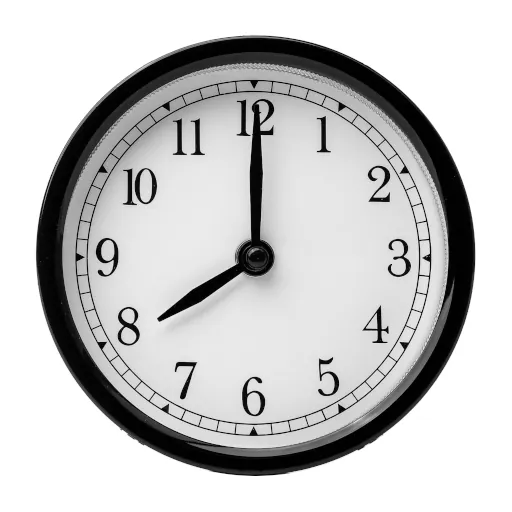Use the interactive clock angle calculator below to visualize and solve the clock angle problem for any time.
Clock Angle Calculator
The clock angle problem is a classic mathematical puzzle that involves calculating the angle between the hour and minute hands of an analog clock at a given time. The clock is a 360-degree circle, and each hand of the clock moves at a constant rate: the hour hand moves slowly as time progresses, while the minute hand moves faster. The challenge is to find the angle between these two hands for any specified time. Below is a detailed explanation of how to solve the problem using the clock angle formula.
1. The Clock as a Circle

A clock is divided into 12 equal sections, one for each hour, and the full circle represents 360 degrees. Since there are 12 hours, each hour mark represents:
360∘ / 12 = 30∘
So, the hour hand moves 30 degrees for each hour. Likewise, the minute hand completes a full circle (360 degrees) in 60 minutes, moving:
360∘ / 60 = 6∘for every minute.
2. Hour Hand Movement
The hour hand moves continuously throughout the day, not just in jumps at the top of the hour. This means that for each minute, the hour hand moves slightly. Specifically, the hour hand moves 0.5∘ per minute because it travels 30 degrees in one hour (i.e., 60 minutes):
30∘ / 60 = 0.5∘ per minute.
3. Minute Hand Movement
The minute hand moves more rapidly than the hour hand, completing a full revolution (360 degrees) in 60 minutes. Hence, it moves 6 degrees per minute:
360∘ / 60 = 6∘ per minute.
The Clock Angle Formula
To find the angle between the hour and minute hands at any given time, we use the following steps:
1. Minute Hand Angle
The angle moved by the minute hand from the 12 o’clock position is given by:
Minute Hand Angle = 6∘ × Minutes.
This calculates how far the minute hand has moved from the 12 o’clock mark.
2. Hour Hand Angle
The angle moved by the hour hand from the 12 o’clock position is given by:
Hour Hand Angle = 30∘ × Hours + 0.5∘ × Minutes.
The first term, 30∘ × Hours, accounts for the movement of the hour hand based on the number of complete hours passed. The second term, 0.5∘ × Minutes, accounts for the fact that the hour hand moves slightly as time progresses within the hour.
3. Finding the Angle Between the Hands
The absolute difference between the two angles (minute hand and hour hand) gives the angle between the hands:
Angle = ∣Hour Hand Angle − Minute Hand Angle∣
This gives the angle in degrees, but since clocks are circular, this could represent either the larger or smaller angle between the hands.
4. Smallest Angle
A clock is circular, so the maximum angle between the hands can never be more than 360 degrees. The actual angle between the hands could be larger than 180 degrees, but often we are interested in the smaller angle. To find the smallest angle, we take the minimum of the calculated angle and its supplement (i.e., 360 degrees minus the calculated angle):
Smallest Angle = min(Angle, 360∘ − Angle)
This ensures that we always return the smaller of the two possible angles.
Conclusion
The clock angle problem demonstrates how mathematical formulas can be used to calculate angles based on the positions of the hour and minute hands of a clock. The core idea is to recognize the rate at which each hand moves and to apply the formulas for both the hour and minute hands to find their respective angles. By subtracting these angles and adjusting for the circular nature of the clock, we can determine the angle between the hands at any given time. You can verify this using the interactive clock angle calculator above.
